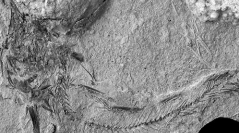

 Geodiversitas
34 (3) - Pages 625-643
Geodiversitas
34 (3) - Pages 625-643The gadid fish Palimphemus anceps Kner, 1862 is redescribed in detail based on 43 specimens from the Miocene deposits of St. Margarethen, in the Eisenstadt-Sopron Basin, Burgenland, Austria. The morphoanatomical analysis of the material referred to Palimphemus anceps revealed that it can be distinguished from other members of the family Gadidae Rafinesque, 1810 by a unique combination of characters, including: elongated and laterally compressed body, head length about ⅓ of SL, large massive neurocranium with outer margins of the frontals thickened and ornamented by longitudinal pits and ridges along the ventral surface, hyomandibula with large ventrally directed preopercular process, opercle with a thick horizontal rib arising from the articular condyle, anal-fin insertion well behind the first dorsal-fin origin; preanal distance exceeding the base length of the first anal fin, length of the first anal-fin base reduced, 45-46 (18 + 27/28) vertebrae, third dorsal fin with 17-21 rays, first anal fin with 18-21 rays, second anal fin with 18-19 rays, caudal fin with 41-43 rays, and pectoral fin with 15-18 rays. Palimphemus anceps appears to be a basal gadine closely related to the genus Micromesistius Gill, 1867. Like other basal gadine genera – Gadiculus Guichenot, 1850, Micromesistius and Trisopterus Rafinesque, 1814 – Palimphemus anceps possibly was a thermophilous gadid that inhabited the shallow waters of the central Paratethys during the Middle Miocene.
Teleostei, Gadiformes, Gadidae, Palimphemus anceps, Miocene, Paratethys, St. Margarethen, Austria